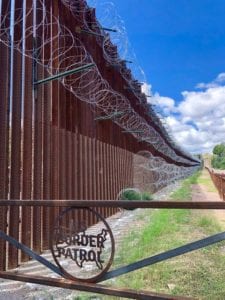JCRC Scene
Beth Salamon
I recently returned from a three-day fact-finding mission to the Arizona-Mexico border with Jewish Council for Public Affairs (JCPA). We were 23 Jewish advocates from 13 states who joined together to bear witness to the immigration crisis on our southern border and to learn how to advocate for better immigration policies.
Since my return, I have struggled to make sense of what I saw and how to put into action what I learned. I still don’t have answers, so I will share my experiences and hope that they will start a conversation.
Our first day was spent touring the area around the border wall. While the current administration has amplified the immigration crisis, the militarization of the border has been decades in the making by both political parties, with successive administrations increasing the border wall and the number of border agents. The policy of “prevention through deterrence” is the U.S. immigration strategy along the southern border, where urban areas are sealed off, forcing migrants to circumvent them and cross through the inhospitable desert. A conservative estimate of people who have died trying to enter the country that way is 7,000.
We then visited a shelter in Nogales, Mexico. Hogar de Esperanza y Paz (HEPAC) is one of four shelters operated by charities in Nogales, where asylum seekers from Cuba, Venezuela, Honduras, Africa, even Russia, safely wait to enter the United States. The shelters maintain lists of families and coordinate with U.S. Customs and Border Patrol (CBP), which allows about 20 or fewer into the country per day. Prior to the creation of this system, the migrants would wait on the streets until CBP would meet with them at the port of entry.
At HEPAC, we talked to a family that traveled for a month from Venezuela with five children, the youngest being 1-year-old twins. The mother wept as she told us how, when she could no longer afford the exorbitant fees imposed by a cartel, her family business was ransacked – as a warning.
We also met a brother and sister who fled Mexico after their parents were assassinated. Once they enter the United States, the current family separation policy will likely require the 20-year-old brother to be placed in a different detention facility than his 12-year-old sister.
At the time of our trip, migrants had a 2 percent chance of winning their asylum case. On the flight home, we learned that the Supreme Court has allowed the enforcement of a new policy where migrants who traveled through a third country to reach the U.S. border will be ineligible for asylum unless they asked for, and were denied, asylum in the countries through which they traveled. Our hearts were broken because, under this ruling, almost every person we met will be denied asylum.

Members of the Jewish Council for Public Affairs visited the southern border in Arizona and met with refugees who were fleeing intolerable conditions in their home countries. (photo provided by Beth Salamon)
Our second day started with a presentation by the Border Patrol, not to be confused with Immigration and Customs Enforcement (ICE). The Border Patrol is responsible for securing 6,000 miles of land border between designated ports of entry. Its mission is to stop illegal border crossings of people and contraband and help people in distress.
Its jurisdiction extends 100 miles into the United States where, to our shock, there are few Fourth Amendment protections. Therefore, the Border Patrol has the authority to stop and search without probable cause or a warrant. We heard many stories of American citizens being stopped and harassed at checkpoints within that zone.
Next, we visited the Casa Alitas Shelter in Tucson. The shelter provides care and short-term shelter and helps to reunite migrants with relatives in the United States. Operated by Catholic Charities, Casa Alitas also receives significant donations from the Jewish Federation of Southern Arizona (JFSA). Upon arrival, these tired families receive a light meal and medical care. They also “shop” in a store with beautiful donated clothes, which we helped fold and sort.
Our next stop was a Federal Courthouse, to observe “Operation Streamline,” an expedited criminal court hearing and sentencing of migrants arrested between ports of entry. In the courtroom we watched as 75 people in handcuffs pleaded guilty, en masse, to illegal entry.
We ended day two with a panel discussion on the “push” factors in Central America that cause the migrants to flee their countries. We learned how failing states, rampant corruption, poverty, climate change and free trade have decimated their way of life. These problems are complicated, not easily fixed and dependent largely on changes in U.S. policy.
Our last day started on an uplifting note, as JFSA and the JCRC hosted us for breakfast at the Federation building in Tucson. There, we heard how the Jewish community is trying to ease the impact of the immigration crisis, and we discussed why getting involved in this issue is a Jewish responsibility.
We ended the trip with a prayer at the Jewish History and Holocaust Museum in Tucson, which is housed in the oldest synagogue in the Arizona territory.
I went on this trip expecting to learn a lot and hoping to find ways to do more. I came away heartbroken and without a clear path forward. This situation is complicated and will need a thoughtful, bipartisan strategy. What I do know is that our current policies are cruel and violate Jewish values. At a minimum we need a more humane approach.
(Beth Salamon, chairman of the Jewish Community Relations Council, wrote this month’s JCRC Scene.)



